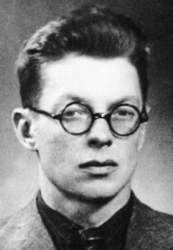Haamer, Eerik 



Eerik Haamer (real name Erich; 17 February 1908 Kuressaare – 4 November 1994 Kungälv, Sweden), an Estonian painter, one of the most powerful Estonian artists of the Pallas generation.
He was born to a family of a civil servant. He completed his basic education in years 1919–26 at Saaremaa Public Gymnasium. In 1928–31 he studied in the Faculty of Physical Education at the University of Tartu; since 1930 in the Art School Pallas, graduated from Pallas in 1935 as a student of Nikolai Triik. After school, he worked as a drawing and gymnastics teacher in Tartu schools and in 1941–44 as a painting, drawing and anatomy professor in Tallinn Industrial Art School (nowadays Estonian Academy of Arts). On 19 September 1944 he escaped from Vilsandi to Sweden in a lifeboat, acted as a record office worker in the museum of Gothenburg and draftsman in the bureau of architecture, since 1964 a freelance artist. Since 1975 he lived in a small town Kungälv near Gothenburg, his summer house was located on a small cliff island in Lyrö in Western Sweden. In search of motives he travelled to Norway, Lapland, Spain and Portugal. In 1970 and 1986 the personal exhibition brought him to Tallinn.
In 1936 he made his first trip to Ruhnu. The nature and the milieu of the island were a source of inspiration and afrequent theme in Haamer’s creative work both before and after leaving his Estonian homeland. One of his favorite subjects was the life of people living on the seacoast, the relationships between man and nature and between man and society („Ruhnu fishermen”, 1938, „Fishermen”, 1940; „A Family in Water”, 1941; „Catching Eel”, 1942, „Sheep Washers”, 1943; Ruhnu. Landscape at Twilight, 1944; „At the fishharbour”, 1950).
He belonged to the Gothenburg Club of Artists.
He was awarded the culture prize of the Society of Swedish Estonians and in 1993 the the medal of honour from the Government of the Republic of Estonia.
He is buried in Kuressaare Kudjape graveyard.
At artist’s homeplace in Kuressaare there is an exhibition house of Haamer family (2004).
Further reading
- R. Kõiv. Eerik Haamer. On Both Sides of the Sea. Kumu Art Museum (2008)
- Works of Eerik Haamer in KUMU
- Works of Eerik Haamer at Estonian Arts Centre (Canada)
- Works of Eerik Haamer At Enn Kunila's Art Collection
- Eerik Haamer Bibliography (in Estonian)
Created in 2013




